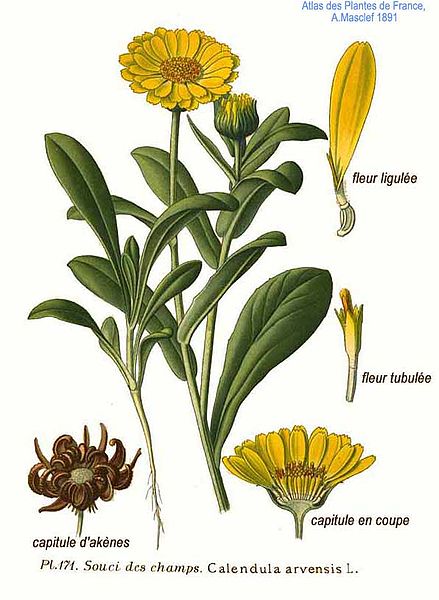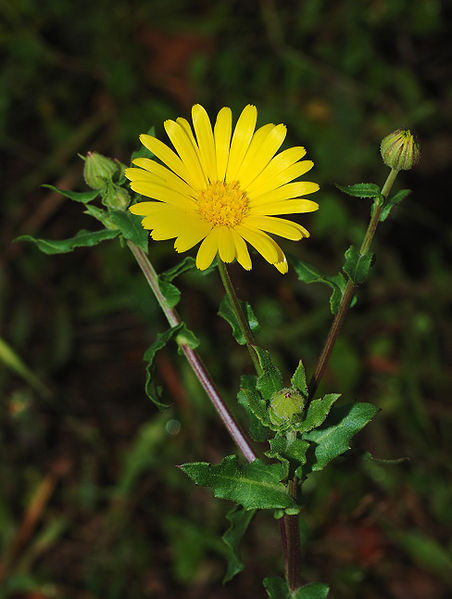 |
|
http://commons.wikimedia.org/wiki/File:171_Calendula_arvensis_L.jpg |
 |
| http://commons.wikimedia.org/wiki/User:Alvesgaspar |
Translate this page:
Summary
Physical Characteristics

 Calendula arvensis is a ANNUAL growing to 0.3 m (1ft).
Calendula arvensis is a ANNUAL growing to 0.3 m (1ft).
See above for USDA hardiness. It is hardy to UK zone 6 and is not frost tender. It is in flower from June to November, and the seeds ripen from August to November. The species is monoecious (individual flowers are either male or female, but both sexes can be found on the same plant) and is pollinated by Bees.
Suitable for: light (sandy), medium (loamy) and heavy (clay) soils, prefers well-drained soil and can grow in nutritionally poor soil. Suitable pH: mildly acid, neutral and basic (mildly alkaline) soils. It cannot grow in the shade. It prefers moist soil.
UK Hardiness Map
US Hardiness Map
Synonyms
Plant Habitats
Cultivated Beds;
Edible Uses
Edible Parts: Flowers Leaves Shoots
Edible Uses:
Young shoots and leaves - raw or cooked[105, 177, 183, 217]. The leaves are very rich in vitamins and minerals, they are similar to Taraxacum officinale (Dandelion) in nutritional value[179]. Flower heads - pickled[177, 183].
References More on Edible Uses
Medicinal Uses
Plants For A Future can not take any responsibility for any adverse effects from the use of plants. Always seek advice from a professional before using a plant medicinally.
Antiphlogistic Antiseptic Antispasmodic Aperient Astringent Cholagogue Diaphoretic Emmenagogue
Homeopathy Skin Stimulant Vulnerary Warts
The leaves are diaphoretic[61, 240]. The flowers are said to be antispasmodic, emmenagogue and stimulant[240]. The plant seems to have similar therapeutic properties to pot marigold, C. officinalis[254]. These properties are:- Pot marigold is one of the best known and versatile herbs in Western herbal medicine and is also a popular domestic remedy[4, 254]. It is, above all, a remedy for skin problems and is applied externally to bites and stings, sprains, wounds, sore eyes, varicose veins etc[4, 254]. It is also a cleansing and detoxifying herb and is taken internally in treating fevers and chronic infections[4, 254]. Only the common deep-orange flowered variety is considered to be of medicinal value[4]. The whole plant, but especially the flowers and the leaves, is antiphlogistic, antiseptic, antispasmodic, aperient, astringent, cholagogue, diaphoretic, emmenagogue, skin, stimulant and vulnerary[4, 7, 9, 21, 46, 165, 201]. The leaves can be used fresh or dried, they are best harvested in the morning of a fine sunny day just after the dew has dried from them[4]. The flowers are also used fresh or dried, for drying they are harvested when fully open and need to be dried quickly in the shade[4]. A tea of the petals tones up the circulation and, taken regularly, can ease varicose veins[201]. An application of the crushed stems to corns and warts will soon render them easily removable[7]. The leaves, blossoms and buds are used to make a homeopathic remedy[232]. It is used internally in order to speed the healing of wounds[232].
References More on Medicinal Uses
The Bookshop: Edible Plant Books
Our Latest books on Perennial Plants For Food Forests and Permaculture Gardens in paperback or digital formats.

Edible Tropical Plants
Food Forest Plants for Hotter Conditions: 250+ Plants For Tropical Food Forests & Permaculture Gardens.
More

Edible Temperate Plants
Plants for Your Food Forest: 500 Plants for Temperate Food Forests & Permaculture Gardens.
More

More Books
PFAF have eight books available in paperback and digital formats. Browse the shop for more information.
Shop Now
Other Uses
References More on Other Uses
Cultivation details
An easily grown and very ornamental plant, it succeeds in any well-drained soil[200], though it prefers a good loam and does best in a sunny or at least partially sunny position[4, 15, 200]. The plant flowers best when it is grown in a poor soil. Plants usually self-sow quite freely in the garden.
References Carbon Farming Information and Carbon Sequestration Information
Temperature Converter
Type a value in the Celsius field to convert the value to Fahrenheit:
Fahrenheit:
The PFAF Bookshop
Plants For A Future have a number of books available in paperback and digital form. Book titles include Edible Plants, Edible Perennials, Edible Trees,Edible Shrubs, Woodland Gardening, and Temperate Food Forest Plants. Our new book is Food Forest Plants For Hotter Conditions (Tropical and Sub-Tropical).
Shop Now
Plant Propagation
Seed - sow in situ from spring to early summer and again in September. The seed germinates best in darkness and usually within 1 - 2 weeks at 21°c[138].
Other Names
If available other names are mentioned here
Native Range
TEMPERATE ASIA: Cyprus, Israel, Jordan, Lebanon, Syria, Turkey, Armenia, Azerbaijan, Georgia, Turkmenistan EUROPE: Belgium, Switzerland, Germany, Hungary, Ukraine (Krym), Albania, Bulgaria, Bosnia and Herzegovina, Greece (incl. Crete), Croatia, Italy (incl. Sardinia, Sicily), North Macedonia, Montenegro, Romania, Serbia, Slovenia, Spain (incl. Baleares), France (incl. Corsica), Portugal AFRICA: Spain (Canarias), Portugal (Madeira Islands), Algeria, Egypt, Libya, Morocco, Tunisia
Weed Potential
Right plant wrong place. We are currently updating this section.
Please note that a plant may be invasive in one area but may not in your area so it's worth checking.
Conservation Status
IUCN Red List of Threatened Plants Status :

Growth: S = slow M = medium F = fast. Soil: L = light (sandy) M = medium H = heavy (clay). pH: A = acid N = neutral B = basic (alkaline). Shade: F = full shade S = semi-shade N = no shade. Moisture: D = dry M = Moist We = wet Wa = water.
Now available:
Food Forest Plants for Mediterranean Conditions
350+ Perennial Plants For Mediterranean and Drier Food Forests and Permaculture Gardens.
[Paperback and eBook]
This is the third in Plants For A Future's series of plant guides for food forests tailored to
specific climate zones. Following volumes on temperate and tropical ecosystems, this book focuses
on species suited to Mediterranean conditions—regions with hot, dry summers and cool, wet winters,
often facing the added challenge of climate change.
Read More
Expert comment
Author
L.
Botanical References
50200
Links / References
For a list of references used on this page please go here
Readers comment
© 2010, Plants For A Future. Plants For A Future is a charitable company limited by guarantee, registered in England and Wales. Charity No. 1057719, Company No. 3204567.